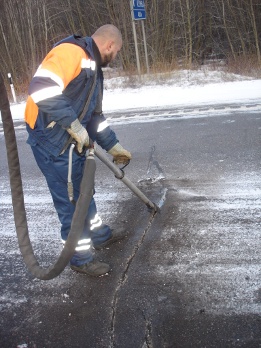After the winter cycle of freeze-thaw-freeze , potholes appear in the road pavement thanks to the continual freezing and thawing of water within the pavement during frosty periods. Water seeps into the pavement through micro-cracks that have not been repaired during the previous season. Unfortunately, not all of the micro-cracks can be spotted during any repair work. The most secure method is to resurface the entire road covering after mending any potholes. This will preserve the covering and water will no longer be able to penetrate it.
Repairing pavement cracks with “CRAFCO”


ÜLE Ltd has long-term experience in repairing pavement cracks with polymer-modified bitumen mastic. In Estonia, this technology mainly suits the repair of so-called temperature cracks which occur on new asphalt coverings. First, the existing crack (which is of a size between 12-20mm wide and 20-25mm deep) is milled, giving it definite margins in order to prevent it developing any further. After that, the milled crack is cleaned with compressed hot air. Then the crack is filled with bitumen mastic. The crack, now covered, differs from the level of the pavement only to a small extent, but is almost unnoticeable under the wheels of a car. Therefore, such technology is irreplaceable in helping to prolong the low noise levels of the covering and ensuring a smooth and level pavement.
Repairing potholes
Over time, ÜLE Ltd has provided various methods for the repair of road pavements. Thanks to all that experience, we have selected two methods to use: winter repairs with a cold mix and blow- patching of the potholes.
1. Pothole repair with a cold mix: used mostly in the autumn-winter-spring period in which the temperature is below 5ºC. The hole is cleaned from dust and debris, and then heated to remove the ice and surplus water from the hole. The cold mix asphalt is added and is later thickened with a rammer or vibration plate. To end with, the upper surface is covered with dry sand; if possible, the plot is surfaced with emulsion and gravel.
2. Pothole repair with the “SAVALCO” equipment by the blow-patching method

By using this method, holes and cracks are first cleaned of dust by the use of compressed air. Next, the patched section receives a base coating of bituminous emulsion and the holes and micro-holes are covered with a mixture of gravel and bituminous emulsion delivered under pressure. The hole is finished off with pure gravel to decrease the bond with the wheels of cars. With this mechanism, it is also possible to patch small micro-holes and surface roads manually. It is possible to continue to work with this method while the ambient temperature remains above zero.
Using a Savalco blow-patcher is one of the safest methods of completing this work, and it is certainly one of the safest for the workers involved in using it, as the entire work process is controlled from the truck’s cabin by one man. Also, the pace of work is fast and efficient, which in its own turn disturbs road users less. Besides this, the use of the distributor is also more favourable for the client, as the work is less time-consuming than when more general equipment is used.
It’s a given that the client will not be very happy when there is loose gravel on the roads and streets after patching. Due to this, we always offer our clients an opportunity for after-cleaning gravel with a vacuum cleaner in order to avoid excessive dust becoming volatile in towns and villages. Naturally, it is impossible to perform after-cleaning on gravel immediately after patch repair work has been carried out. Gravel and bituminous emulsion need time for formation. Therefore, depending on the weather, the formation period might last between two to seven days.
